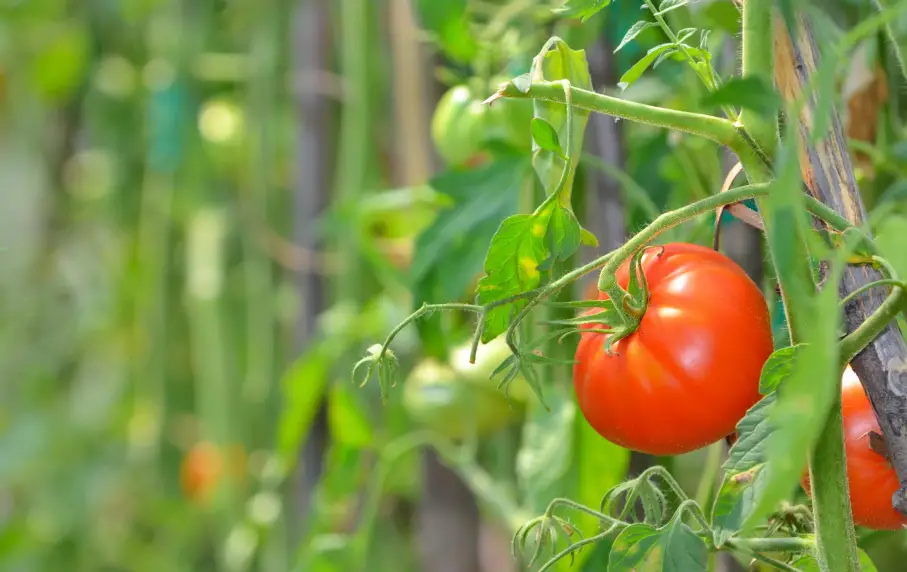Organic tomato fertilizer: its advantages and disadvantages
Since 2010, Tomato Dirt has garnered 4.8+ million views, making it the web’s leading online source for growing tomatoes in the home garden. Award-winning writer and Tomato Dirt owner Kathy Widenhouse has helped thousands of home gardeners grow healthier tomatoes. Be one of them when you get Tomato Dirt’s Growing Guide here.
Updated 6.10.25
Organic tomato fertilizers are made up of materials that are naturally-occurring plant or mineral matter. Inorganic fertilizers, on the other hand, are chemically synthesized byproducts of the petroleum industry. In other words, a fertilizer is classified as “organic” or “inorganic” by its source. Does it naturally occur (even if it must be processed)? Or is it synthetically produced?
Other differences between organic and inorganic fertilizer
- At a molecular level, there is little difference between organic and inorganic fertilizers. Nitrogen behaves the same whether it was organically or inorganically sourced.
- Inorganic fertilizers may not be as beneficial for the environment, since they may contain some non-biodegradable matter or chemicals that may be harmful to humans and wildlife. Organic fertilizer’s make up is 100% biodegradable and can be used safely.
- From a financial standpoint, organic fertilizers are about 20% more expensive if purchased than their inorganic counterparts. Yet over time, that investment may be recouped with improved soil and larger crops so characteristic to organic produce. Or the cost for organic fertilizer may be negligible if the gardener has means to cultivate her own (such as garden compost or composted manure).
Organic tomato fertilizer
Advantages for the gardener to using organic tomato fertilizer
- Improves the soil long-term by helping organic matter break down Contains trace nutrients, rather than just the top three major nutrients (nitrogen, phosphorus, potassium)
- Releases nutrients gradually and lasts longer in soil
- Available in both granular and liquid (fish emulsion) forms
Disadvantages for the gardener to using organic tomato fertilizer
- Three major nutrients (nitrogen, phosphorus, potassium) are not balanced
- Weaker strength means fertilizing more often during the growing season, which can increase expenses
- Can contain damaging pathogens if fertilizer is not properly composted
Types of organic tomato fertilizer
- Alfalfa meal (good nitrogen source)
- Blood meal (good nitrogen source)
- Bone Meal (good phosphorus source)
- Compost (good nitrogen source)
- Cottonseed meal
- Dried or composted manure: tends to be low in phosphorus. Apply with bone meal to provide a balanced nutrient mix.
- Feather meal (good nitrogen source)
- Fish emulsion
- Fish meal (good nitrogen source)
- Granite dust (also called rock potash) – slow-releasing (good potassium source)
- Leaf mold (good nitrogen and potassium source)
- Legumes (good nitrogen source)
- Tomato Tone (4-7-10): a granular fertilizer that is worked into the soil. Tomato Tone is organic and contains calcium, magnesium, sulfur and trace nutrients. It also contains a blend of beneficial microbes.
- Wood ash (good potassium source)
Inorganic fertilizer
Advantages for the gardener to using inorganic fertilizer
- Releases nutrients quickly to get more timely results (this is especially helpful when tomato plants with yellowed leaves or for plants that may be malnourished)
- Available in both granular and liquid forms.
Disadvantages for the gardener to using inorganic fertilizer
- Most don’t contain trace nutrients which can mean problems in tomatoes. For example, a calcium deficiency, when accompanied by inconsistent watering, can lead to blossom-end rot in tomatoes.
- Inorganic fertilizers break down quickly in the soil. Tomatoes will require more frequent feedings.
- Granular forms can burn plants.
Types of inorganic fertilizer for tomatoes
- Ammonium nitrate
- Ammonium sulfate
- Anhydrous ammonia
- Calcium nitrate
- Miracle Gro for Tomatoes (18-18-21): a crystal formula that is mixed with water and applied through a hose, sprayer, or sprinkler
- Potassium nitrate
- Potassium sulfate
- Rock phosphate
- Rock sand
- Sodium nitrate
- Super phosphate
- Urea
More about tomato fertilizer
What Nutrients Do Tomatoes Need?
What’s the Best Tomato Fertilizing Schedule?
Fertilizing Tomatoes: Frequently Asked Questions ...
How to use tomato fertilizer to get the best production ...
Kinds of tomato fertilizer ...
Epsom salts: a natural tomato fertilizer ...
Does tomato fertilizer potency stay strong over time?
Tomato fertilizer question: will this fertilizer work?
More on growing tomatoes
Preparing your soil for planting tomatoes ...
Watering tomatoes when planting and just afterwards ...
Watering tomato plants: the basics ...
Techniques for watering tomato plants ...
Watering tomatoes: FAQs (Frequently Asked Questions)...
How and when to mulch tomatoes ...
What's the best mulch for tomatoes?
Staking tomatoes for a bigger harvest ...
How to control weeds in the the tomato garden ...
Pruning tomato plants: how and when to do it ...
Growing tomatoes: top 4 areas of tomato care ...
Get more info on our Fertilizing Tomatoes Pinterest board...
Return from Organic Tomato Fertilizer to Tomato Dirt home
As an Amazon Associate and Rakuten Advertising affiliate I earn from qualifying purchases.
SHARE THIS PAGE:
FREE! 10 Must-Know Tomato Growing Tips: 20-page guide
Get yours here:









New! Comments
Have your say about what you just read! Leave a comment in the box below.